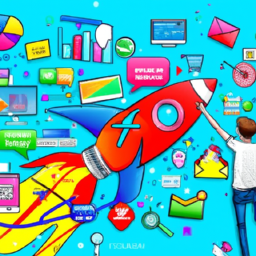Driving Engagement with Gamified Marketing
When it comes to marketing, capturing the attention and engaging customers is crucial. With the ever-increasing competition and short attention spans, marketers are constantly on the lookout for innovative and effective strategies to stand out from the crowd. One such strategy that has gained popularity in recent years is gamified marketing, which combines the power of games with marketing tactics to drive customer engagement.
What is gamification?
Gamification is the integration of game mechanics, design elements, and game thinking into non-gaming environments, such as marketing campaigns. It involves using elements like points, badges, leaderboards, challenges, and rewards to make the experience more engaging and enjoyable for customers.
How does gamification drive customer engagement?
1. Creates a sense of excitement and fun: Games have this magical ability to capture people’s attention and make them want to participate. By incorporating gamified elements into your marketing strategy, you can create a sense of excitement and fun, which motivates customers to engage with your brand.
2. Increases customer interaction: Gamified marketing encourages customers to interact with your brand in various ways. Whether it’s answering quizzes, completing challenges, or sharing content, gamification motivates customers to actively participate, leading to increased engagement.
3. Builds loyalty and rewards: Rewards are an integral part of gamified marketing. By offering customers incentives like discounts, exclusive content, or even tangible rewards, you create a sense of loyalty and encourage repeat engagement. This not only drives customer engagement but also increases customer retention.
4. Creates a sense of competition: Leaderboards and rankings play a significant role in gamified marketing. By allowing customers to compete with each other and track their progress, you tap into their competitive nature, triggering a desire to engage more and climb up the ranks. This sense of competition can drive a high level of engagement and keep customers coming back for more.
5. Enhances learning and brand awareness: Gamification can be a powerful tool for educating customers about your brand, products, or services. By incorporating educational elements into games, you can provide valuable information in an entertaining and interactive way. This not only enhances the learning experience but also increases brand awareness.
Examples of gamified marketing
Several brands have successfully implemented gamified marketing strategies to drive customer engagement. Here are a few examples:
- Starbucks Rewards: Starbucks implemented a gamified loyalty program that rewards customers with stars for each purchase. As customers accumulate stars, they level up and gain access to additional perks.
- Nike+ Run Club: Nike developed a running app that tracks users’ running performance and rewards them with badges, achievements, and challenges to encourage them to keep running and engage with the brand.
- Duolingo: Duolingo, a language-learning platform, uses gamified elements like scoring, streaks, and leveling up to motivate users to learn new languages and engage with the app regularly.
Conclusion
Gamified marketing is a powerful strategy that can drive customer engagement by creating excitement, increasing interaction, building loyalty, triggering competition, and enhancing learning. By incorporating gamified elements into your marketing campaigns, you can capture the attention of your target audience and keep them engaged with your brand. So, unleash your creativity, think like a game designer, and start gamifying your marketing efforts to achieve greater success!


